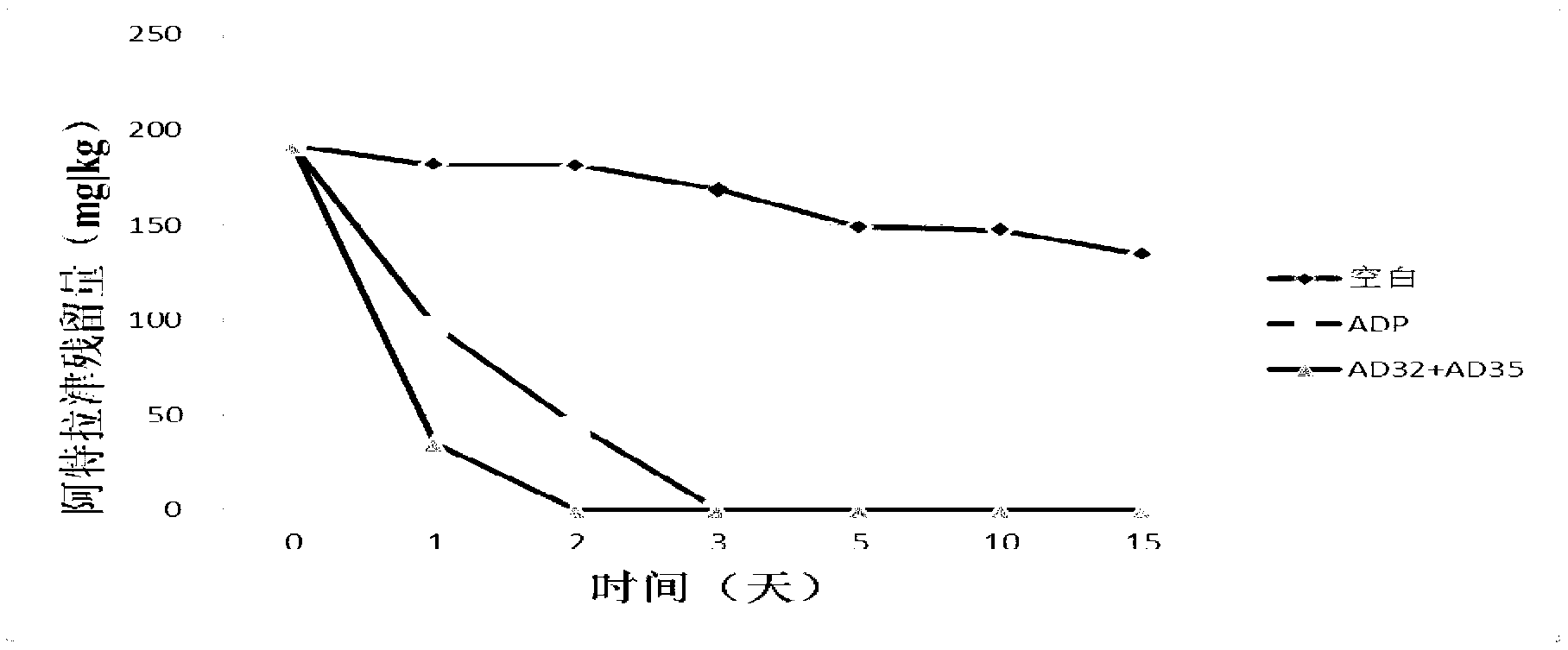Method for recovering herbicide atrazine-polluted soil by using degradable bacteria
A technology of atrazine and contaminated soil, applied in the field of contaminated soil remediation, to achieve the effect of reducing operation steps
- Summary
- Abstract
- Description
- Claims
- Application Information
AI Technical Summary
Problems solved by technology
Method used
Image
Examples
Embodiment 1
[0021] Example 1 Remediation of Atrazine Contaminated Soil by Arthrobacter AD32 and Pseudomonas AD35 Mixed Bacteria (Low Concentration Cells)
[0022] 1. Collect the cells from 20mL Arthrobacter AD32 and Pseudomonas AD35 by centrifugation respectively, wash the cells with 0.9% NaCl solution and sterile water successively, suspend the cells in sterile water after centrifugation, and then divide the cells at a ratio of 1:1 Ratio (OD 600 Numerically equal) mixed, after centrifugation, the cells were suspended in a medium containing 3g / L sucrose and 0.3g / L phosphate (0.2g Na 2 HPO 4 12H 2 O, 0.1g KH 2 PO 4 ) solution, so that the cell concentration is 10 4 individual / mL.
[0023] 2. Add 10 g of sterilized soil, 2 mg of atrazine, and 500 μL of AD32 and AD35 mixed bacterial suspension into a sterile petri dish with a diameter of 9 cm, and incubate at 30°C for 10 days. Pseudomonas ADP cells were used as a positive control, and soil not inoculated with bacteria was used as a ne...
Embodiment 2
[0026] Example 2 Remediation of Atrazine-Contaminated Soil by Mixed Bacteria of Arthrobacter AD32 and Pseudomonas AD35 (High Concentration Cells)
[0027] 1. Collect the cells from 20mL Arthrobacter AD32 and Pseudomonas AD35 by centrifugation respectively, wash the cells with 0.9% NaCl solution and sterile water successively, suspend the cells in sterile water after centrifugation, and then divide the cells at a ratio of 1:1 Ratio (OD 600 Numerically equal) mixed, after centrifugation, the cells were suspended in a medium containing 3g / L sucrose and 0.3g / L phosphate (0.2g Na 2 HPO 4 12H 2 O, 0.1g KH 2 PO 4 ) solution, so that the cell concentration is 10 8 individual / mL.
[0028] 2. Add 10 g of sterilized soil, 2 mg of atrazine, and 500 μL of AD32 and AD35 mixed bacterial suspension into a sterile petri dish with a diameter of 9 cm, and incubate at 30°C for 5 days. Pseudomonas ADP cells were used as a positive control, and soil not inoculated with bacteria was used as a...
PUM
 Login to View More
Login to View More Abstract
Description
Claims
Application Information
 Login to View More
Login to View More - R&D
- Intellectual Property
- Life Sciences
- Materials
- Tech Scout
- Unparalleled Data Quality
- Higher Quality Content
- 60% Fewer Hallucinations
Browse by: Latest US Patents, China's latest patents, Technical Efficacy Thesaurus, Application Domain, Technology Topic, Popular Technical Reports.
© 2025 PatSnap. All rights reserved.Legal|Privacy policy|Modern Slavery Act Transparency Statement|Sitemap|About US| Contact US: help@patsnap.com



